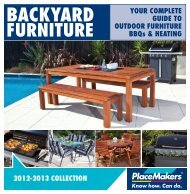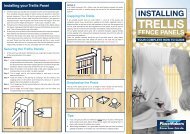Maintaining your home. - Placemakers
Maintaining your home. - Placemakers
Maintaining your home. - Placemakers
Create successful ePaper yourself
Turn your PDF publications into a flip-book with our unique Google optimized e-Paper software.
HOW TO<br />
21<br />
<strong>Maintaining</strong><br />
<strong>your</strong> <strong>home</strong>.<br />
www.placemakers.co.nz
<strong>Maintaining</strong> <strong>your</strong> Home<br />
Regular maintenance keeps <strong>your</strong> house looking good,<br />
maintains its value and maximises the life of the building<br />
materials.<br />
Regular checks of <strong>your</strong> <strong>home</strong><br />
• Identify immediate problems.<br />
• Allow planning for major maintenance.<br />
• Enable early planning of renewal projects.<br />
Annual routine<br />
Keep track of both checks and maintenance with an annual<br />
routine. Checks take only 2 or 3 hours every 6 or 12<br />
months.<br />
Roofs & Spouting<br />
Roof inspections must be approached carefully to ensure<br />
that the risk of falling or slipping is minimised. Ensure that<br />
the roof is dry and that the ladder is secure (preferably<br />
tied to a solid object) and at the correct angle (1M out from<br />
the wall for every 4M of height). Other roof inspection<br />
requirements are:<br />
• be careful when adjacent to electrical wires, particularly<br />
with aluminium ladders on steep roofs, use a roof ladder.<br />
• for PVC guttering, installing a timber block within the<br />
gutter immediately behind the ladder and after the ladder<br />
is erected protects the gutter from being crushed.<br />
• for profiled steel roofing, walk only along the fixing<br />
lines.<br />
• for tiled roofs, step only on the front edge of the tile -<br />
for full inspections lay a plank over the tiles and use it<br />
as a walk way.<br />
Check for;<br />
Generally - valleys blocked with leaves and dirt.<br />
Metal roofs - loose fixings, ridging and flashings, rust,<br />
flaking or cracked paint.<br />
Clay and concrete tiles - cracked or loose tiles, cracked<br />
mortar.<br />
Spouting - leaks (holes or leaking joints) rust in steel<br />
guttering, broken brackets, blockages or outlets. Water<br />
should drain completely from the gutter.<br />
Action<br />
1. Replace loose roofing fixings with spiral shanked roofing<br />
nails or screws that have sealing washers.<br />
1
2. Have cracked tiles replaced.<br />
3. Clean out blocked valleys.<br />
4. Seal gaps and holes with appropriate sealant (may be<br />
temporary).<br />
5. Clean out spouting: especially before winter. WARNING<br />
-For corrugated steel roofs, wear leather gloves.<br />
6. Clear all downpipe outlets. Consider fitting plastic<br />
spouting mesh where close to trees.<br />
7. Wash down roof. Recommended 6 monthly for uncoated<br />
metals and 3 monthly if near the sea.<br />
Exterior walls (Best done in spring)<br />
Paintwork<br />
Check for;<br />
Peeling or flaking paint, particularly on corners, edges<br />
and joints where paint fails first. North and west walls<br />
receive more destructive UV rays than south facing walls,<br />
which are usually damper.<br />
Action<br />
1. Sand or scrape off existing paint, prime or seal bare<br />
cladding material and repaint.<br />
Timber and sheet claddings<br />
Check for;<br />
Any damaged cladding: impact damage to fibre cement<br />
board, EIFS and Stucco, broken or rotten battens.<br />
Vertical board damage: especially where bottom edges<br />
touch soil, roof, deck or flashing.<br />
Rot: especially at joints between different materials and<br />
where water can be trapped.<br />
Gaps or opening of joints: often on mitred corners.<br />
Uncoated weatherboards: particularly cracking.<br />
Loose fixings or cladding.<br />
Cracked or split sealant filled joints.<br />
Sealing around pipes or other items penetrating the<br />
cladding.<br />
Cracking of monolithic claddings (cracks need to be<br />
repaired as soon as possible).<br />
Coating deterioration on monolithic claddings (look<br />
particularly at any horizontal surfaces and anywhere<br />
water can lie on the surface).<br />
Action<br />
1. Wash down exterior at least annually. Washing off<br />
abrasive dirt, salt, mould and dust, extends the material<br />
life.<br />
2
2. Clean every surface: paintwork, windows (both glass and<br />
frame), brick and blockwork.<br />
3. Use a soft brush and low-pressure hose. Concentrate on<br />
areas rain doesn't reach, like soffits and walls sheltered by<br />
eaves.<br />
4. Rinse off any detergent residue with clean water.<br />
Bricks, blocks, plaster and concrete<br />
Check for;<br />
Cracks.<br />
Crumbling mortar between bricks.<br />
Drumming sounds from solid plaster.<br />
Action<br />
1. Wash down annually.<br />
2. Repair cracked or loose mortar or drummy plaster.<br />
Also check for;<br />
Evidence of movement or subsidence, via planks or boards<br />
that seem out of line or level, or for walls or chimneys out<br />
of plumb.<br />
Overflowing toilet cisterns or hot water cylinder drain pipes.<br />
Loose window putties.<br />
Corrosion of deck and post fittings. For subsidence obtain<br />
specialist advice before carrying out repairs.<br />
Action<br />
1. Wash down exterior at least annually. Washing off abrasive<br />
dirt, salt, mould and dust, extends the material life.<br />
2. Clean every surface: paintwork, windows (both glass and<br />
frame), brick and blockwork.<br />
3. Use a soft brush and low-pressure hose. Concentrate on<br />
areas rain doesn't reach, like soffits and walls sheltered by<br />
eaves.<br />
4. Rinse off any detergent residue with clean water.<br />
5. Remove any soil piled up against walls. Unblock or create<br />
sub floor vents or brick veneer drainage slots.<br />
6. Lubricate hinges and locks.<br />
Underfloor<br />
Take a strong torch and get into the sub floor space if possible.<br />
Dig a crawl space if necessary. Buildings with a concrete<br />
perimeter foundation should have a trap door or hatch in the<br />
floor, usually in the laundry. Cut a hatch if not.<br />
Check for;<br />
Damp soil, wet building surfaces, leaks, and rot.<br />
Look for possible causes:<br />
3
- Disconnected waste pipe.<br />
- Leaking pipe.<br />
- Blocked drain or gully traps.<br />
- Inadequate underfloor ventilation.<br />
- Leaking bath or shower.<br />
- Surface run-off going under house.<br />
- High water table.<br />
Sagging or broken structural timbers: caused by borer,<br />
too much notching through timber to run services, or<br />
too large a span.<br />
Tears or gaps in insulation.<br />
Damaged or loose wiring and unsupported pipes.<br />
Corroded metal fixings: tie wires, staples, nail plates,<br />
bolts.<br />
Loose structural bolts.<br />
Gaps between pile and bearer or loose wedges.<br />
Rotten timber piles; test by thrusting heavy screwdriver<br />
Into the pile just below ground level.<br />
Cracks in concrete walls: N.B. New or worsening cracks<br />
should be checked by a builder or engineer.<br />
Action<br />
1. Remove all rubbish, rubble and building debris.<br />
2. Repair or tighten leaking pipes and wastes.<br />
3. Clear drains and gulley traps.<br />
4. Have soil drains dug.<br />
5. Treat or replace corroded metal fittings.<br />
6. Tighten pile wedges.<br />
7. Unblock or create sub floor vents.<br />
8. Support insulation, wiring and pipes.<br />
9. To replace piles, bearers, rotten timber or badly cracked<br />
walls, or deal with subsidence, consult a qualified builder.<br />
Roof space<br />
Check for;<br />
Condensation on underside of roofing paper or roofing<br />
material which can be caused by lack of ventilation or<br />
roofing paper.<br />
Wet insulation. Look for possible causes:<br />
- Leaks in roof or pipes.<br />
- Extractor fan venting into roof space.<br />
- Condensation (see above).<br />
Leaks or water stains.<br />
Corrosion of metal fittings or roofing.<br />
4
Displaced insulation.<br />
Obvious active borer infestation.<br />
Sagging beams or rafters.<br />
Insecure, worn or rubber sheathed wiring.<br />
Evidence of rats, mice or birds.<br />
Insecure header tank or hot water cylinder: (earthquake<br />
risk).<br />
Action<br />
1. Repair leaks in roofing or pipes.<br />
2. Redistribute or add insulation to achieve total coverage.<br />
3. Replace badly borer ridden structural timbers.<br />
4. Have sagging beams strengit1ened (consult reputable<br />
builder).<br />
5. Remove rats/mice/birds nest.<br />
6. Secure loose pipes or tanks.<br />
Interior<br />
Check for;<br />
Evidence of dampness: mildew, water stains or residual<br />
dampness, bubbling floor vinyl, failing paint or clear<br />
finishes, buckled hardboard, sagging ceilings, mouldy or<br />
lifting wallpaper, rot in window frames.<br />
Failing paint and timber finishes.<br />
Springy flooring.<br />
Squeaky flooring.<br />
Jammed windows.<br />
Sticking doors.<br />
Sticking locks.<br />
Action:<br />
1. Dampness: improve ventilation, insulation and heating.<br />
Vent clothes driers outside. Reduce the use of kerosene<br />
and LPG heaters.<br />
2. Prepare and repaint where necessary.<br />
3. For squeaky floors:<br />
Screw and glue a batten to underside of each of a line of<br />
floorboards.<br />
Screw and glue a batten onto floor joists, pushed hard up<br />
under the flooring.<br />
Paint the floor with flooring oil, or sprinkle with talcum<br />
powder.<br />
4. For jammed windows:<br />
5
Wait until dry spell before forcing open. Replace worn<br />
hinges and/or strip too thick paint on edges.<br />
5. For sticking doors:<br />
Ensure door is dry, plane top or bottom (whichever is<br />
sticking) or the hinge side, until 2mm gap all round.<br />
Repaint or varnish edge. Where the hinge side is planed,<br />
reset the hinges and rehang the door.<br />
6. Lubricate sticking locks with graphite powder.<br />
Bathrooms & Kitchens<br />
Check for;<br />
Lifting or loose tiles.<br />
Cracked tiles or grout.<br />
Rot in wet wall linings: especially around tap or shower<br />
mixer/rose and along bottom edge.<br />
Degraded sealant around baths, tubs and basins.<br />
Dripping taps.<br />
Action:<br />
1. Reglue or replace tiles.<br />
2. Replace tile grout with waterproof grout or suitable<br />
silicone sealant.<br />
3. Replace rotten wet wall linings.<br />
4. Strip out old sealants, clean gap and reseal.<br />
5. Replace tap washers.<br />
Getting professional help<br />
In some cases, you may not be confident about taking<br />
remedial or maintenance action <strong>your</strong>self. You may not even<br />
be sure what the problem is. In those cases, seek professional<br />
advice and diagnosis from a builder, plumber, electrician,<br />
engineer or building consultant. Do that sooner rather than<br />
later. The consultation will cost the same whenever it's done,<br />
but the cost of dealing with a problem will only increase,<br />
if left unattended.<br />
Common Tasks<br />
Finding a roof leak<br />
1. With a soft flow head, gently hose over one small area<br />
of the roof at a time.<br />
2. Start at the bottom and work up.<br />
3. Have someone Inside the roof space checking for leaks<br />
as you go.<br />
6
Replacing rotten timber<br />
1. Cut away a further 600mm on each side of rot if possible.<br />
2. Cut square so new piece of timber is easy to fit.<br />
3. Paint exposed timber with timber preservative.<br />
4. Cut replacement piece from H3 treated timber.<br />
5. Prime all round with two coats.<br />
6. Fix in place: nail or screw with glue.<br />
7. Fill joint with flexible paintable sealant .<br />
Easing a binding door<br />
1. Check for loose hinges.<br />
2. Remove loose screws.<br />
3. Replace with larger ones, or fill screw holes with glued<br />
in dowel, then redrill and screw as before.<br />
4. Check the thickness of paint on the door edge. Strip and<br />
repaint if necessary.<br />
If binding is caused by building movement or subsidence,<br />
that must be rectified before repairing the door or it will<br />
probably recur.<br />
TIP - With loose pin hinges, the door can be removed<br />
without taking the hinges off.<br />
Produced in association with<br />
The Building Research Association of New Zealand<br />
Please Note:<br />
Whilst the advice and recommendations contained in this brochure<br />
have been produced with proper care, they are offered only with<br />
the objective of assisting those interested in <strong>home</strong> improvement projects<br />
and PlaceMakers does not accept responsibility for the advice,<br />
recommendations, etc. contained herein.<br />
Information correct at time of printing: December 2002<br />
7

















